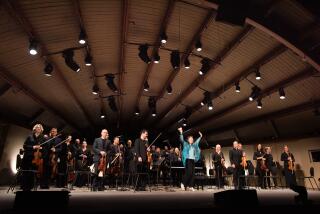JAZZ REVIEW : Variety Provides Spice at Educators Fest
- Share via
MIAMI — “All languages today have become secondary to our first language, which is jazz.”
Not an original thought, perhaps, but the source made it noteworthy. The words were spoken Friday by a representative of the U.S. government. As part of a speech made by John E. Frohnmayer, chairman of the National Endowment for the Arts, they preceded the presentation of this year’s awards to three “American Jazz Masters,” each of whom received a congratulatory letter from President Bush accompanied by a check for $20,000.
The honorees were pianist Dorothy Donegan and trumpeter Harry (Sweets) Edison, both of Los Angeles, and singer Betty Carter. All three, who had begun their careers when jazz was in the cellar of America’s art community, offered gracious acceptance speeches, then ad-libbed a number with the Count Basie Orchestra, onstage at the James L. Knight Center, a 3,500-seat auditorium.
The ceremony was one of the highlights of the 19th annual conference of the International Assn. of Jazz Educators, held here from Thursday through Sunday. This somewhat improbable title denotes a unique and valuable organization.
Launched in 1968, when jazz was unwelcome in most schools, the IAJE has mushroomed into a powerful force, with 1,700 members in 23 countries. The conventions have become a virtual three-ring circus--part trade exposition, part marathon think tank and part jazz festival. On this last level it comes close to outstripping many of the more commercial, musically hybrid events.
The conference is funded in part by the National Endowment for the Arts, with help from such concerned citizens as Herb Alpert (creator of the Gil Evans and Louie Armstrong fellowships, the winners of which were presented here). The event is a heady assortment of live concerts by world-class artists, clinics by both jazz men and academics, along with displays by music publishers, overseas festivals, jazz magazines and universities, hawking their wares in booths at a vast exhibitors area. It all happens in the Hyatt Regency Hotel complex which includes two large theaters.
Among more than 100 events (including eight clinics or recitals every hour on the hour), none seemed likely to top an amazing display of virtuosity by Eddie Daniels, who has become the Art Tatum of the clarinet. Leading a quartet, he drew gasps of admiration from a crowd of 2,500 Thursday at the Knight Center.
Darius Brubeck fielded a fascinating mix of American and African concepts as he led his “Jazz Connection” septet, composed mainly of black and white musicians from the integrated University of Natal in South Africa, where he has been head of the Jazz Studies department since 1983. His younger brother Danny guested with the group on drums. The tunes were harmonically simpler, involving occasional lyrics (in Zulu) along with hymn-like themes and touches of Art Blakey.
Los Angeles composer Clare Fischer brought his intriguing assortment of American, Portuguese and Spanish elements into play with a group built around five singers, who dealt with every language well enough to beat the New York Voices at their own game.
Fortifying the international ambience were flutist Paquito d’Rivera and trumpeter Arturo Sandoval, the Cuban virtuosi, who were here, like many of the visitors, to give both a concert and a clinic. Also present was the formidable Canadian pianist Oliver Jones, whose hard-driving trio included the expatriate drummer Ed Thigpen, in from Copenhagen. Less impressive was a band of faculty members from the University of Duisberg, Germany, playing be-bop.
The avant-garde coup of the weekend was scored by Jane Ira Bloom, the Yale alumna who achieved stunning polyphonic effects with her soprano sax. Bloom’s tour de force was the coupling of her own composition, inspired by Joan Miro, with Thelonius Monk’s “Straight No Chaser.” “This is what might happen if Monk had met Miro,” she explained.
The changes in the IAJE reflect the evolution of American society. In the early years it was a virtually all-white enclave, but through the efforts of later presidents, black educators and students were drawn in. Today, the president is a noted black saxophonist Bunky Green, from North Florida University’s music department. The vice president is another black musician-educator, Ellis Marsalis, from the University of New Orleans.
More to Read
The biggest entertainment stories
Get our big stories about Hollywood, film, television, music, arts, culture and more right in your inbox as soon as they publish.
You may occasionally receive promotional content from the Los Angeles Times.










